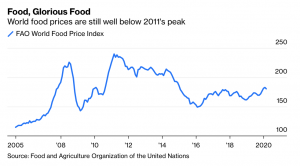During COVID-19 Outbreak, Some Countries Restrict Ag Exports
Wall Street Journal writers Kirk Maltais and Joe Wallace reported this week that, “Consumers are loading up on pasta, rice and bread. Farm supply lines are disrupted. Countries are restricting agricultural exports.
The result: Prices of wheat and rice, two of the world’s staple grains, are rising sharply. Difficulties moving grain within countries and across borders, coupled with frenzied buying, could exacerbate the impact of the pandemic on the global food market.
“The price of wheat futures trading in Chicago, the global benchmark, has risen 15% since mid-March and reached as high as $5.72 a bushel Monday, bucking the coronavirus-induced economic downturn that has hurt most commodity markets.”

The Journal article stated that, “The United Nations’ Food and Agriculture Organization says logistical issues, along with the falling value of emerging-market currencies, are conspiring to make grains more expensive for food-importing nations. That has the potential to create a food crisis in poorer countries, as well as regions hit hard by the pandemic.”
The Journal writers added that, “To be sure, the world isn’t about to run out of food…But getting it to the right places is proving a problem.”
Meanwhile, Reuters News reported this week that, “Kazakhstan will introduce quotas on its exports of wheat and flour and lift the ban on flour exports introduced this month to ensure steady domestic supply amid the coronavirus crisis, the Kazakh Agriculture Ministry said on Monday.”
And on Tuesday, Reuters News reported that, “The government has yet to approve the agriculture ministry’s proposal to limit Russian grain exports to 7 million tonnes from April through June, but the economy ministry said on Monday it backed the idea.”
Bloomberg writer Heesu Lee reported this week that, “Russia, Kazakhstan and Ukraine have already announced plans to limit wheat exports, and in Asia worries over making sure there’s enough food for everyone have now spread to rice, the main staple for billions of people in the region. China and India are the biggest global producers and consumers.”

The Bloomberg article pointed out that, “The reality is that there is no actual shortage. Warehouses in India, the world’s largest exporter, are brimming over with rice and wheat on record harvests. Global production of milled rice is estimated at around a record 500 million tons in 2019-20 and global stockpiles are at an all-time high of more than 180 million tons, according to the U.S. Department of Agriculture.”
In response to some of these restrictions, Reuters writer Stephanie Nebehay reported this week that, “Food supply chains must be protected from any trade-related measures taken during the COVID-19 pandemic, the heads of the World Trade Organization (WTO) and U.N. food and health agencies said on Tuesday, warning of possible shortages and price spikes.
“They voiced concern that disruptions to the movement of agricultural and food industry workers or food containers could result in the spoilage of perishables and increasing food waste and said protectionism was also a risk.
‘Uncertainty about food availability can spark a wave of export restrictions, creating a shortage on the global market,’ WTO director-general Roberto Azevedo, and the heads of the World Health Organization Tedros Adhanom Ghebreyesus and the U.N.’s Food and Agriculture Organization Qu Dongyu said.
And Clara Ferreira Marques pointed out this week in a Bloomberg Opinion column that, “In much of the world, preemptive policies can keep things moving. China’s Ministry of Agriculture and Rural Affairs, for example, brought in incentives for sowing and mechanization in early February, as well as support for livestock farming, and ‘green channels’ to help the movement of feed, breeding animals and produce. Governments can encourage trade, rather than nation-level hoarding. As the virus spreads, wealthier countries may also need to support developing ones, especially those hit by elevated import bills and weakened currencies.
“Disruptions will be inevitable. A global food crisis doesn’t have to be.”

In other news regarding COVID-19 and the movement of agricultural commodities, Reuters writers Hugh Bronstein and Maximilian Heath reported this week that, “Argentine shipments of soymeal, soybeans, corn and other agricultural exports were delayed as the government ramps up inspections of incoming cargo ships to ensure crew members were free of coronavirus, industry sources said on Monday.
“While Argentine growers were harvesting Southern Hemisphere fall crops unimpeded by health measures taken against the pandemic, supply from the world’s biggest exporter of soymeal livestock feed was slowed as some municipal authorities refused to let grains trucks drive through their jurisdictions.”
And Reuters writer Jake Spring reported this week that, “China has not approved any new Brazilian meat plants for export this year because of the coronavirus pandemic, an official at Brazil’s Agriculture Ministry told Reuters, adding that all approvals were on hold until the crisis eases.”
Source: Keith Good, Farm Policy News
